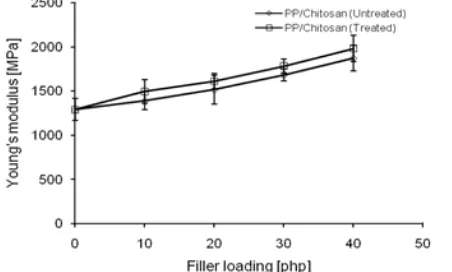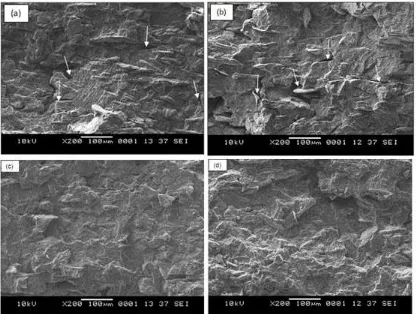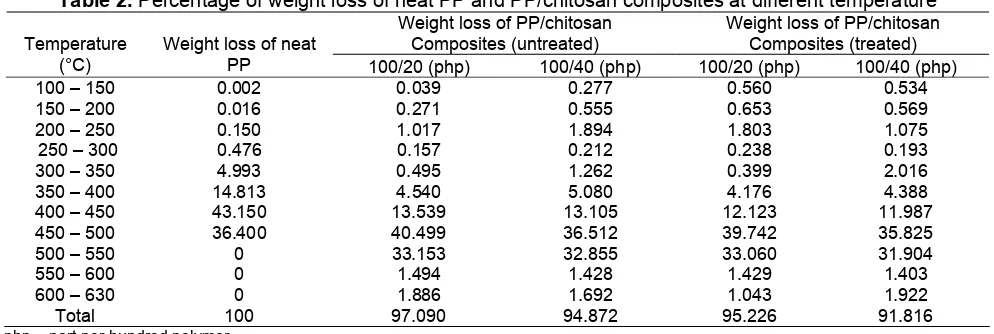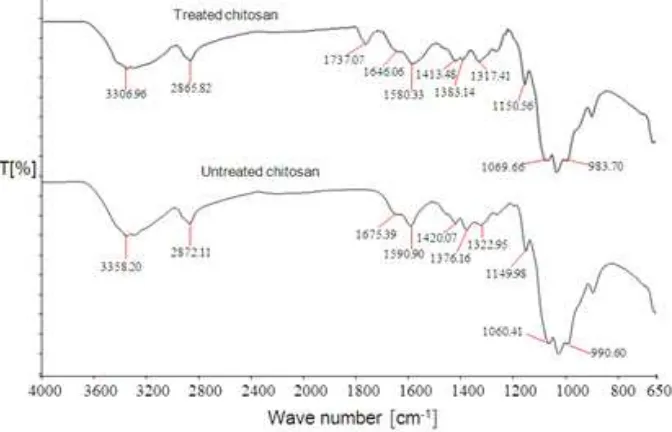Faisal Amri Tanjung et al.
* Corresponding author. Tel/Fax : +604-9798178 Email address : [email protected]
CHEMICALLY CHITOSAN MODIFIED WITH METHYL METHACRYLATE
AND ITS EFFECT ON MECHANICAL AND THERMAL PROPERTIES
OF POLYPROPYLENE COMPOSITES
Faisal Amri Tanjung1,*, Salmah Husseinsyah1, Kamarudin Hussin1, and Iqmal Tahir2
1
School of Materials Engineering, Division of Polymer Engineering Universiti Malaysia Perlis, 02600, Jejawi, Perlis, Malaysia
2
Department of Chemistry, Faculty of Mathematics and Natural Sciences, Universitas Gadjah Mada, Sekip Utara, Yogyakarta Indonesia 55281
Received February 6, 2013; Accepted July 2, 2013
ABSTRACT
Effects of methyl methacrylate on the properties of chitosan-filled polypropylene (PP) composites has been investigated. Mechanical and thermal properties of the composites were analyzed according to ASTM D 638-91, thermogravimetry analysis (TGA) and differential scanning calorimetry (DSC). The results showed that tensile strength of PP composites decreased upon the addition of chitosan, while Young’s modulus improved. At a similar filler loading, the treated PP/chitosan composites were found to have higher tensile strength and Young’s modulus as compared with the untreated composites. Thermal analysis results showed that thermal stability and crystallinity of the treated composites were higher than the untreated ones. Scanning electron microscopy (SEM) and Fourier transforms infrared (FTIR) studies revealed less detached filler from matrix on tensile surface of the treated composites as an evidence of enhanced filler-matrix interfacial adhesion due to formation of ester-bridge between the chitosan and the methyl methacrylate.
Keywords: polypropylene; chitosan; composites; methyl methacrylate; interfacial adhesion
ABSTRAK
Pengaruh metil metakrilat terhadap sifat-sifat komposit polipropilena (PP) terisi kitosan telah diteliti. Sifat mekanik dan sifat termal komposit dianalisis menggunakan ASTM D 638-91, analisis thermogravimetri and differential scanning calorimetry (DSC). Hasil-hasil yang diperoleh menunjukkan bahwa kekuatan tarik komposit PP menurun dengan penambahan kitosan, sedangkan modulus Young meningkat. Pada jumlah pengisi yang sama, komposit PP/kitosan dengan perlakuan ternyata memiliki kekuatan tarik dan modulus Young yang lebih tinggi dibandingkan dengan komposit tanpa perlakuan. Analisis termal menunjukkan bahwa kestabilan termal dan kristalinitas komposit dengan perlakuan lebih tinggi daripada komposit tanpa perlakuan. Kajian SEM dan FTIR menunjukkan pengurangan pengisi yang terlepas dari matriks pada permukaan patahan komposit dengan perlakuan sebagai sebuah bukti peningkatan ikatan antarmuka pengisi dan matriks yang disebabkan pembentukan jembatan-ester antara kitosan dan metil metakrilat.
Kata Kunci: polipropilena; kitosan; komposit; metil metakrilat; ikatan antarmuka
INTRODUCTION
Recently, the utilization of natural fibers as filler or reinforcement in thermoplastic composites is being more attractive. This trend is mainly encouraged by economic and environmental factors [1]. Since thermoplastic composites prepared using natural fibers are inexpensive and could minimize environmental pollution due to their characteristics bio-degradability, they could play a vital role in solving the environmental problems [2-3]. Among the advantages of using natural fibers in
Faisal Amri Tanjung et al.
A large number of natural fibers are being used as filler to replace mineral fillers, such as wood fiber [9], sawdust [10], waste paper [11], jute [12], rice husk [13], sisal [14], and chitosan [15]. Chitosan is known as the second most abundant natural fiber after cellulose. It is extracted from crustaceous shells such as crabs, shrimp and prawns [16]. Currently, active researches have been conducted in the application of chitosan as biomaterials due to its biodegradability, biocompatibility and non toxicity, in spite of low cost, resource abundances, lightness and non abrasive nature [17].
The mechanical and physical properties of natural fiber filled thermoplastic composites are strongly influenced by the interaction on the interface between filler and matrix [18]. The interaction between the two components can be enhanced by physical and chemical modification of the filler or by using suitable coupling agents. Coupling agents are able to react with both components during the preparation of the composites, creating a chemical bridge at the filler–matrix interface [19-20].
Chitosan is a natural polysaccharide which tends to absorb water due to its hydrophilic characteristic, responsible to poor filler and matrix interfacial interaction. This becomes major drawback of using chitosan as filler in thermoplastic composites. This problem could be overcome by treating the filler. A number of attempts have been carried out in order to enhance the interaction between chitosan fiber and hydrophobic matrix. Salmah et al. [21] reported that the interfacial adhesion between chitosan and PP matrix was significantly enhanced by employing the 3-aminopropyltriethoxysilane (3-APE) as the chemical modifying agent in composite systems. In addition, in our previous work we have reported that better interfacial bonding and higher tensile strength of chitosan filled polypropylene (PP) composites were obtained by chemically treating the chitosan with sodium dodecyl sulfate [22].
In this study, methyl methacrylate was used as chemical modifying agent for treating the chitosan filler to enhance the interfacial interaction with PP matrix. Methyl methacrylate was chosen due to its reactive chemical moieties that may react with polar groups of chitosan i.e. hydroxyl and amine groups, to form a chemical bonding [23]. The formation of chemical bonding between chitosan and methyl methacrylate is expected to decrease the hydrophilic character of chitosan leading to enhance interfacial adhesion. Therefore, this study was aimed to investigate the effect of chemical treatment of chitosan by using methyl methacrylate on mechanical and thermal properties of polypropylene (PP) composites, while varying the chitosan loading.
EXPERIMENTAL SECTION
Materials
Polypropylene (PP) homopolymer used in this study was injection molding grade S11232 G112, from Polypropylenas Sdn Bhd (Malaysia) with MFI (melt flow index) value of 45 g/10 min at 230 °C. Chitosan was obtained from Hunza Nutriceuticals Sdn Bhd (Malaysia) with average size of 80 µm and degree of deacetylation (DD) of 90%. Ethanol (98%.v/v) and methyl methacrylate were obtained from Aldrich.
Instrumentation
A Z-blade Mixer (MCN ELEC Co., Taiwan) was used for preparation of the composite. Tensile tests were carried out according to ASTM D 638-91 on an Instron 5582. Thermal analyses were investigated by using TGA Q500 Perkin Elmer Instrument and Perkin Elmer TA Instrument DSC Q 1000. A scanning electron microscope (SEM), model JSM 6260 LE JEOL, was used to study surface morphology of composites. FTIR spectroscopy analysis of untreated and treated chitosan was carried out in ATR mode by using Perkin-Elmer 1600 Series.
Procedure
Preparation of treated chitosan
Methyl methacrylate solution was prepared in ethanol at temperature of 40 °C. The amount of methyl methacrylate used was 3 vol.% of filler. The solution was then cooled down to room temperature. Afterward, chitosan was gradually added to the solution while slowly stirred. The mixture was mechanically stirred for 2 h in order to be homogenized and stayed overnight. The precipitate was filtered and then dried in the oven at 80 °C for 24 h to remove ethanol residue.
Preparation of PP/chitosan composites
Faisal Amri Tanjung et al.
Table 1. Formulation of untreated and treated PP/chitosan composites
Materials Untreatedcomposites Treatedcomposites
Polypropylene (PP) (php) 100 100
Chitosan (php) 0, 10, 20, 30, 40 10, 20, 30, 40
Methyl methacrylate (vol.%) - 3
php = part per-hundred polymer
Fig 1. Stress versus strain traces of neat PP and PP/chitosan composites with and without treatment
Fig 2. Effect of filler loading on tensile strength of PP/chitosan composites
Fig 3. Effect of filler loading on Young's modulus of PP/chitosan composites
formulation of untreated and treated PP/chitosan composites is summarized in Table 1.
Characterizations
Tensile tests were carried out according to ASTM D 638-91. At least, five dumbbell specimens of each composition with thickness 1 mm were cut from the molded sheets with a Wallace die cutter. A cross head speed of 20 mm/min was used and the test was performed at 25 ± 3°C.
Thermogravimetric (TGA) and derivative thermogravimetric (DTG) analyses were investigated to study the thermal stability of the composites. Samples were scanned on TGA, from 30 to 600 °C at a heating rate of 20 °C/min using a nitrogen flow of 50 mL/min. On DSC analysis, samples were scanned from 25 to 250 °C at a heating rate of 20 °C/min using nitrogen flow of 50 mL/min. The melting and enthalpy of PP/chitosan
composites were automatically calculated by the instrument software. The crystallinity of composites (Xc) was determined using Equation 1:
100 / o
c f f
X H x H (1)
where ∆Hf is the heat of fusion of the PP and composites, Hfo is the thermodynamic heat of fusion of fully crystalline PP (209 J/g) [24]. A mean value of three replicates of each specimen was recorded.
Study on the morphology of the tensile fracture surface of the PP/chitosan composites was carried out by using a scanning electron microscope (SEM). The fracture ends of specimens were mounted on aluminium stubs and sputter coated with a thin layer of palladium to avoid electrostatic charging during examination.
Fourier transforms infra red (FTIR) spectroscopy analysis of untreated and treated chitosan was carried out. Samples were scanned from 650 to 4000 cm-1 with resolution of 4 cm-1.
RESULT AND DISCUSSION
Tensile Properties of PP/Chitosan Composites
Faisal Amri Tanjung et al.
Fig 4. SEM micrograph of tensile surface; (a) untreated PP/chitosan composite (20 php); (b) untreated PP/chitosan composite (40 php); (c) treated PP/chitosan composite (20 php); (d) treated PP/chitosan composite (40 php); all magnifications are 200X. Arrows indicate traces of pulled out filler
ultimate strain than neat PP. The presence of chitosan as filler significantly influenced the strength of PP composites. Chemical treatment did not apparently change the stress versus strain trace character of the treated PP composites, but influenced the measured strength at failure. The use of methyl methacrylate increased both strength and ultimate strain of treated PP composites when compared to untreated ones.
Tensile strength of PP/chitosan composites as a function of filler loading is depicted in Fig. 2. Tensile strength of PP/chitosan composites decreased with the increasing of filler loading, which considerably due to the lack interfacial interaction between chitosan and PP matrix. Chitosan is natural polysaccharide with hydrophilic character, while PP is hydrophobic polymer. The different polarities diminish filler-matrix interfacial adhesion [25]. Hence, as the chitosan loading increased thereby increasing the interfacial area, the worsening interfacial interaction between filler and matrix has caused decreasing tensile strength. However, as the presence of methyl methacrylate on the chitosan surface, the tensile strength of treated PP composites was higher compared to untreated ones. It is worth
noting that the hydrophilic character of chitosan was decreased due to the formation of ester-linkage between hydroxyl group of chitosan and ester group of methyl methacrylate through trans-esterification reaction, leading to enhanced interfacial adhesion with PP matrix.
Faisal Amri Tanjung et al.
Fig 5. TGA curve of untreated and treated PP/chitosan composites
Fig 6. DTG curve of untreated and treated PP/chitosan composites
Table 2. Percentage of weight loss of neat PP and PP/chitosan composites at different temperature
Weight loss of PP/chitosan Composites (untreated)
Weight loss of PP/chitosan Composites (treated) Temperature
(°C)
Weight loss of neat
PP 100/20 (php) 100/40 (php) 100/20 (php) 100/40 (php)
100 – 150 0.002 0.039 0.277 0.560 0.534
150 – 200 0.016 0.271 0.555 0.653 0.569
200 – 250 0.150 1.017 1.894 1.803 1.075
250 – 300 0.476 0.157 0.212 0.238 0.193
300 – 350 4.993 0.495 1.262 0.399 2.016
350 – 400 14.813 4.540 5.080 4.176 4.388
400 – 450 43.150 13.539 13.105 12.123 11.987
450 – 500 36.400 40.499 36.512 39.742 35.825
500 – 550 0 33.153 32.855 33.060 31.904
550 – 600 0 1.494 1.428 1.429 1.403
600 – 630 0 1.886 1.692 1.043 1.922
Total 100 97.090 94.872 95.226 91.816
php = part per-hundred polymer
SEM Study of PP/Chitosan Composites
Fig. 4 shows SEM micrographs of tensile fractured surface of PP/chitosan composites. The micrographs of untreated PP/chitosan composites (Fig. 4(a) and 4(b)) show the appearance of voids indicating detached filler from the matrix. This is mainly due to poor wetting of the filler by the matrix. The fracture occurred at the interface between chitosan and PP matrix. The different polarities between filler and matrix lead to lack interaction on the interface especially at higher filler loading. However, the less voids are observed on the tensile surface of treated PP/chitosan composites (Fig. 4(c) and 4(d)). A good wetting of the filler by the matrix is related to the presence of methyl methacrylate, which hydrophobically modifies the chitosan, leading to enhanced interfacial adhesion with PP matrix.
Thermal Properties of PP/Chitosan Composites
Fig. 5 and 6 demonstrate TGA and DTG curve of neat PP, untreated and treated PP/chitosan composites. The
Faisal Amri Tanjung et al.
observation clearly exhibits that neither the presence of chitosan filler at higher loading nor the presence of methyl methacrylate did alter the thermal degradation mechanism of PP/chitosan composites.
Fig. 7 shows DSC curves of neat PP, untreated and treated PP/chitosan composites at 20 php filler loading. Table 3 summarizes the melting temperature (Tm), fusion enthalpy (∆Hf) and degree of crystallinity (Xc) of neat PP, untreated and treated PP/chitosan composites. As can be seen, the addition of chitosan filler did not significantly change the Tm of PP composites, but, decreased the degree of crystallinity (Xc). This indicates that the presence of chitosan in PP composites apparently become barrier on nuclei-growth of PP chain and delayed the crystallization process. Furthermore, the addition of natural filler into PP matrix obstructed the mobilization of the PP macromolecular chain and prevented the macromolecular segment from obtaining ordered alignment of the crystal lattice [26]. On the other hand, the treated PP/chitosan composites were obtained to have higher crystallinity than untreated PP/chitosan composites, remarkably due to enhanced interfacial bonding between chitosan and PP matrix. It is worth noting that methyl methacrylate favors the enhanced chitosan-PP matrix interfacial interaction, leading to increased crystallinity of PP composites. The treated chitosan surfaces were indicated as nuclei– growth sites for promoting the crystallization process in PP composites. However, the Tm did not significantly change when compared with untreated composites, possibly due to the non- uniformity of crystal shape and lattice resulting from different types of nucleation sites [27].
FTIR Study of Untreated and Treated Chitosan
Fig. 8 presents the FTIR spectra of untreated and treated chitosan. As can be seen, the infrared (IR) spectrum of untreated chitosan, the main characteristic
Fig 7. DSC curve of untreated and treated PP/chitosan composites containing filler loading of 20 php
Table 3. Summary of Tm and Xc of neat PP and PP/chitosan composites
Composites Tm (°C) Xc(%)
Neat PP 162(0.2) 38.74(0.3)
PP/chitosan: 100/20 (untreated) 163(0.3) 24.13(0.2)
PP/chitosan: 100/40 (untreated) 163(0.1) 19.81(1.0)
PP/chitosan: 100/20 (treated) 164(0.5) 28.59(0.5)
PP/chitosan: 100/40 (treated) 164(0.3) 22.76(0.4)
php = part per-hundred polymer; Tm = melting temperature; Xc =
crystallinity degree
Faisal Amri Tanjung et al.
peaks of chitosan, are at 3358 cm-1 (O–H stretch), 2872 cm-1 (C–H stretch), 1675 cm-1 (N–H bend) and 1590 cm-1 (C=O stretch). The IR spectrum of treated chitosan exhibits a significant absorption on the band of -OH group from 3358 to 3306 cm-1, indicating the reduction in hydrophilic character of chitosan. This is attributed to the presence of ester-bridge as a result of trans-esterification reaction between ester group of methyl methacrylate and hydroxyl group of chitosan as identified by the presence of the absorption band at 1737 cm-1. The formation of this bonding is also supported by the reduction of the bands at 1675 cm-1 to 1646 cm-1 and 1590 cm-1 to 1580 cm-1, indicating N–H bending vibration and amide I (C=O) stretching vibration of chitosan chain.
CONCLUSION
Chitosan, a kind of natural filler was incorporated into PP matrix to produce composite materials. Methyl methacrylate was employed as chemical treating agent to reduce the polar character of the chitosan filler. Tensile test results showed that the incorporation of chitosan filler into PP matrix reduced the tensile strength, but increased the Young’s modulus. The treated PP/chitosan composites were observed to have higher tensile strength and Young’s modulus than untreated PP/chitosan composites. The thermal analysis results showed that the treated PP/chitosan composites had higher thermal stability and crystallinity than untreated ones. Additionally, it was found that chemical treatment did not alter the thermal degradation mechanism of treated PP/chitosan composites when compared with untreated ones. FTIR spectra and SEM micrographs revealed that methyl methacrylate was successfully bonded onto the chitosan surface, leading to enhanced interfacial adhesion with PP matrix.
ACKNOWLEDGEMENT
Research fund under Fundamental Research Grant Scheme (FRGS) by Ministry of Science, Technology and Innovation (MOSTI) of Malaysia is greatly acknowledged.
Technol., 67, 13, 2838–2846.
5. Nuñez, A.J., Sturm, C.P., Kenny, M.J., Aranguren, M.I., Marcovich, N.E., and Roberedo, M.M., 2003,
J. Appl. Polym. Sci., 88, 6, 1420–1428.
6. Avella, M., Casale, L., Dell'erba, R., Focher, B., Martuscelli, E., and Marzetti, A., 1998, J. Appl.
Polym. Sci., 68, 7, 1077–1089.
7. Abdelmouleh, M., Boufi, S., Belgacem, M.N., and Dufresne, A., 2007, Compos. Sci. Technol., 67, 7-8, 1627–1639.
8. Ashori, A., and Nourbakhsh, A., 2010, Composites
Part B, 41, 7, 578–581.
9. Dányádi, L., Móczó, J., and Pukánszky, B., 2010,
Composites Part A, 41, 199–206.
10. Fernanda, M.B., Coutinha, H.C., Joao, C.S.M., and Daniele, P.M., 2000, Polym. Test., 19, 625–629. 11. Faisal, A., and Salmah, H., 2012, J. Thermoplast.
Compos. Mater., 25, 193–207.
12. Chand, N., and Dwivedi, U.K., 2006, Wear, 261, 10, 1057-1063.
13. Panthapulakkal, S., and Sain, M., 2007,
Composites Part A, 38, 6, 1445–1454.
14. Li, H., Hi, C., and Yu, Y., 2008, Composites Part A, 39, 4, 570–578.
15. Kabiri, K., Mirzadeh, H., and Zohuriaan-Mehr, M.J., 2007, Iran. Polym. J., 16, 3, 147–151.
16. Di Martino, A., Sittinger, M., and Risbud, M.V., 2005, Biomaterials, 26, 30, 5983–5990.
17. Prashanth, H.K.V., and Tharanathan, R.N., 2007,
Trends Food Sci. Technol., 18, 3, 117–131.
18. Balasuriya, P.W., Ye, L., Mai, Y-W, and Wu, J., 2002, J. Appl. Polym. Sci., 83, 12, 2505–2521. 19. Bengtsson, M., and Oksman, K., 2006, Composites
Part A, 37, 5, 752–765.
20. Gironès, J., Méndez, J.A., Boufi, S., Vilaseca, F., and Mutjé, P., 2007, J. Appl. Polym. Sci., 103, 6, 3706–3717.
21. Salmah, H., Faisal, A., and Kamarudin, H., 2011,
Int. J. Polym. Mater., 60, 7, 429–440.
22. Faisal, A., Salmah, H., and Kamarudin, H., 2013, J.
Thermoplast. Compos. Mater., (in press) Doi:
10.1177/0892705711430430.
23. Supri, A.G., Tan, S.J, Ismail, H., and Teh, P.L., 2011, Polym. Plast. Technol. Eng., 50, 898–906. 24. Joseph, P.V., Joseph, K., Thomas, S., Pillai,
C.K.S., Prasad, V.S., Groenickx, G., and Sarkissova, M., 2003, Composites Part A, 34, 3, 253–266.
Faisal Amri Tanjung et al.
26. Sui, G., Fuqua, M.A., Ulven, C.A., and Zhong, W.H., 2009, Bioresour. Technol., 100, 3, 1246–1251.



